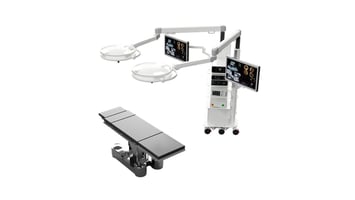Ambulatory Healthcare Design Lab (AHD*lab) seeks to explore innovations in healthcare design and...
How Anesthesia Innovations are Revolutionizing Outpatient Total Joint Procedures
Advances in anesthesia have played a significant role in enabling the growth of total joint surgery in the outpatient setting. Outpatient total joint surgery, also known as ambulatory or same-day joint replacement surgery, allows patients to undergo joint replacement procedures and return home on the same day, rather than staying in the hospital for an extended period. This approach offers several benefits, including reduced healthcare costs, faster recovery, and increased patient satisfaction. Here are some ways in which advances in anesthesia have contributed to the success of outpatient total joint surgery:
1. Regional Anesthesia Techniques: The development and refinement of regional anesthesia techniques, such as epidurals, peripheral nerve blocks, and spinal anesthesia, have been crucial in facilitating outpatient joint surgery. These techniques can provide effective pain relief, allowing patients to recover more comfortably and return home sooner.
2. Improved Pain Management: Anesthesia providers have gained a better understanding of pain management strategies, including the use of multimodal analgesia. By combining various medications and techniques, they can control pain more effectively, reducing the need for opioids and minimizing side effects.
3. Enhanced Patient Safety: Anesthesiologists and nurse anesthetists have become skilled at tailoring anesthesia protocols to individual patient needs. This personalized approach to anesthesia minimizes the risk of complications, ensuring that patients can safely undergo surgery as outpatients.
4. Rapid Recovery Protocols: Anesthesia teams work closely with orthopedic surgeons to develop rapid recovery protocols. These protocols aim to optimize patient outcomes by reducing the time it takes to regain mobility and return to normal activities.
5. Minimizing Postoperative Nausea and Vomiting (PONV): Advances in anesthesia have led to better management of PONV, a common side effect of surgery and anesthesia. Reducing the incidence of PONV can enhance patient comfort and satisfaction during the postoperative period.
6. Outpatient Anesthesia Protocols: Specific anesthesia protocols have been developed with the unique needs of outpatient joint surgery in mind. These protocols focus on minimizing the duration of anesthesia and ensuring patients are alert and stable for discharge.
7. Enhanced Monitoring: Advances in monitoring technology allow anesthesiologists to closely track a patient's vital signs and response to anesthesia. This continuous monitoring helps ensure patient safety throughout the procedure and recovery.
8. Patient Education and Preoperative Optimization: Anesthesia providers play a crucial role in educating patients about what to expect during surgery and recovery. They work with patients to optimize their health before the procedure, reducing the risk of complications and facilitating a successful outpatient experience.
Advances in anesthesia have contributed to the growth of outpatient total joint surgery by making it safer, more efficient, and more patient-friendly. This approach aligns with the broader trend in healthcare toward minimally invasive procedures and shorter stays, ultimately improving the overall experience for patients undergoing joint replacement surgery.






